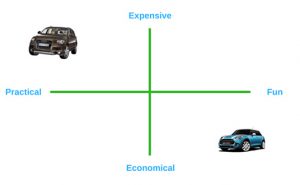Even when life gets busy, we should still make time for our hobbies. “All work and no play” is draining and doesn’t foster creativity.
Positioning is the essence of marketing strategy, and some would say of all business strategy.
It’s about how your business is different from the others. It’s about what your business does for people that other businesses don’t do.

THE POSITIONING STATEMENT TEMPLATE
I’m not sure where this classic positioning statement template started, or whom to credit, but I’ve found it very useful for years of developing business plans. “For [target market description] who [target market need], [how our business offering meets the need]. Unlike [key competition], it [most distinguishing feature].”
Here’s an example of that template in action for a social media consulting service, with the components separated:
“For [small business owners who want social media marketing but don’t have time to do it themselves], our social media services [do it for them without taking their time and effort]. Unlike [most social media consulting], [we don’t just advise; we do the work].”
Another example for a healthy fast food restaurant:
“For [busy people who want healthy foods but need fast meals], [we offer organic healthy fast foods]. Unlike [most fast foods offerings], we [offer fresh local ingredients, organic, grilled not fried, with a lot of vegetables and vegetarian options, and free-range meats].”
The examples show how the positioning statement sets the business and its offering apart from others. It implies strategic focus and a strategic match between target market, market need, and business offering. It’s a great tool to help you view your own business strategically, and to explain your strategy to outsiders when necessary.
POSITIONING DIAGRAMS
I also like to explain positioning graphically with diagrams, like this simple one from Philip Kotler’s iconic textbook, “Marketing Management,” that shows positioning related to breakfast:

The diagram illustrates simple positioning related to breakfast. Breakfast can be slow or quick, and expensive or inexpensive. Pancakes might compete with hot cereal for slow and inexpensive, but bacon and eggs are different because they are slow and expensive. The instant breakfast doesn’t compete with bacon and eggs. That’s positioning.
To do your own positioning diagram, start with creative thinking about how you can divide your market in terms of variables that make strategic sense. In the example below I decided to organize the automobile market according to two factors: economical versus expensive, and practical versus fun. If I were looking to position specific cars with this, I’d put a luxury SUV on one extreme as practical and expensive; and a Mini-Cooper on another, as economical but fun.

You may notice that the positioning diagram example here is a lot like the competitive matrix that appears in many business plans. That similarity is not an accident. The competitive matrix that appears in many plans and pitches is a direct descendent of the positioning diagram that Philip Kotler first popularized in the 1970s and 1980s.
What I wrote in an earlier discussion of the competitive matrix also applies here, with positioning:
“Don’t, please, discount [this] as an internal tool to help with strategy development and specifics of designing products”




